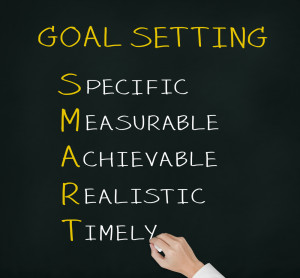Last I posted, we were Finding a Theme in Our Dreams. Our resolutions are starting to take shape and we’re identifying some of the actions we will take to achieve them. Think of it as your very own Personal Improvement Project Plan. Today’s post builds on the idea of defining the long-term goals, and it’s something I started practicing when I was in the corporate world, both in my professional and personal endeavours – using the SMART formula in objective setting.

There are a few different variations to the SMART acronym. The one I’ve used for myself, as well as with my clients is: Specific, Measurable, Action Oriented, Realistic and Time Bound. For every long-term goal you create, it should have all 5 elements of SMART in order for it to be a goal you are more likely to achieve. By now, if you’ve been following the tips in the Resolution to Reality Series, you should be at a point where you have picked 2 – 3 resolutions (AKA: long-term goals) you want to move forward with. Review those resolutions against the SMART philosophy and see if you are well on your way or if you need to make some minor revisions 😉
- Specific: What do you want to achieve? It needs to be something tangible that you can easily identify what success looks like when the goal is reached. You need to dream it, visualize it and answer the questions who, what, when, where and why. Get the goal to as detailed a statement as possible.
- Measurable: As a Personal Trainer and Health at Every Size advocate, the Measurable part of SMART has always been a challenging concept for me to work through. On the one-hand, I can definitely see the benefit in measuring something in order to track your progress. However, I get stumped when the goal is one around health and fitness. Generally, if we’re making a health or fitness goal, there tends to be an element of changing one’s body shape or size. And the most common measurements to use would be to step on a scale, figure out body fat percentage and/or use a measuring tape to track body composition changes. All of these lead us down a path of negativity, because inevitably there comes a day/week/month where we do not hit that target and we are frustrated, discouraged and see ourselves as failures. Instead, if one of your resolutions is centred around health and wellness:
- Please don’t make it about the weight!
- Instead try to create your own scale focused on how you feel and what’s going on from the inside/out.
- Use internal measurements for assessing your stress, energy and/or hunger levels.
- Just remember to be honest in your assessments and clear on what those personal rankings mean.
- Action Oriented: Here is where you need to specify the activities or tasks you will be doing to reach your goal; week after week, month after month, until that resolution is reached.
- Realistic: Identifying attainable objectives will get you closer to reaching that longer range goal without depleting you physically and mentally. For example, setting a goal of completing a 5k race in 3 months before completing a half marathon by the end of the year, still challenges you but makes it more likely you’ll get to that bigger race if you take the baby steps first.
- Time bound: Set a date and mark it on the calendar to keep you focused and on-task.
If you’re interested in taking those positive resolutions and making them happen, join Michelle at her Resolution to Reality Workshop. Click here to find out more.
Leave a Reply